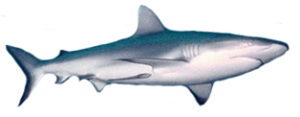
If we are fortunate, our lives will be blessed by at least a few experiences which are transcendent. These occurrences surpass all others in the emotions they evoke, the curiosity they inspire, or their ability to remind us just how remarkable a human existence can sometimes be. These are encounters which long reside in our memories. They arise, frequently unbidden, to remind us that we live in a world of wonder. They prompt us to recall that the human experience is often awe-inspiring. I have been fortunate indeed. Now in the autumn of my life, providence has graced me with a host of such memories. Here is one I would share with you.
As a rural youngster my world was small. But, I sometimes heard stories proposing that tropical paradises existed somewhere far away. Most often it was said that these were islands located in the remote reaches of the Pacific Ocean. The tales proclaimed that such places were of great natural beauty and blissful solitude. As a young man of 28, I found that these stories were true.
I had come to learn that lying off the northeastern coast of Peninsular Malaysia was a pair of islands. Pulau Perhentian Kecil (little) and Pulau Perhentian Besar (big) rested 12 miles offshore of the mainland, their beaches languidly caressed by the tepid waters of the South China Sea. I had also been told that the larger of the two islands was uninhabited and fringed by pristine coral reefs of rich biodiversity and stunning beauty. Snorkel over an unspoiled coral reef? Never had I ever. Living in Malaysia at that time, this was an opportunity that demanded a commitment.
My wife Anne, daughter Michelle (then an 8 year-old), and I loaded our venerable Mitsubishi Colt with water, rice, canned fish, and fruit enough for a few days and headed for the little town of Kuala Besut, 330 miles to the northeast. We drove westward across the Malay Peninsula the first day and spent an evening in the ocean-side town of Kuantan. The ensuing drive up the east coast revealed a landscape totally different than the western side of Malaysia where we lived. This was in 1974 and at that time the east coast’s seasonal monsoon had caused development to lag far behind that on the western side of the peninsula’s mountainous spine. We drove for miles along beautiful, sandy beaches that were totally undeveloped. A Malay kampong (village) devoted to a fishing economy occasionally appeared through the windshield. Otherwise our drive was without evidence that humans actually inhabited this beautiful coast.
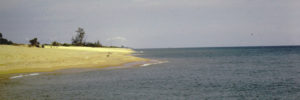
Arriving in Kuala Besut, we connected with a few other Peace Corps friends who were going out to Pulau Perhentian with us. Combining our supplies and making a quick inventory to ensure we had all we needed, we discussed the issue of just how we were going to get out to the island. It seemed to hover tantalizingly close. Though shrouded by a blue haze imparted by its distance, the rainforest-covered island loomed on the western horizon, its lurking mysteries tugging at us like a potent magnet.
We needed a boat obviously. But this was long ago. No ferry plied the steel blue waters lying between the small fishing village and our island destination. There were no trendy outfitters where one might purchase any camping equipment known to man. Kuala Besut was devoid of even a single company devoted to capitalizing upon visiting tourists. But, there were lots of fishing boats. Perhaps we could hire one to take us out to the big island. With that, we began a march along the shoreline where the Malay 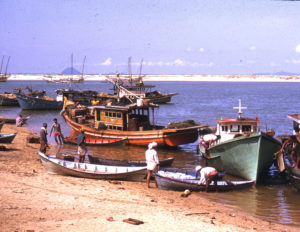 fisherman had drawn up their vessels. Luck was with us. The third fisherman we queried said yes; he would take us out to Pulau Perhentian and come back and pick us up in three days. The negotiated price (to be paid when he came back for us) was 50 Ringgit (about US$23 at that time).
fisherman had drawn up their vessels. Luck was with us. The third fisherman we queried said yes; he would take us out to Pulau Perhentian and come back and pick us up in three days. The negotiated price (to be paid when he came back for us) was 50 Ringgit (about US$23 at that time).
Into the little wooden boat we piled our supplies and excitedly climbed aboard to begin our adventure. Perhaps, at this point, some of you may be wondering why on earth we would take an 8 year-old child out to an uninhabited island for three days. I can only plead the ignorance of youth; my youth that is! As I have aged, it has become quite apparent to me that people in their 20’s don’t think like people in their 70’s. I suppose this is why 20 year-olds make good soldiers, racing drivers, rock climbers. It simply never occurred to us that anyone could get hurt. None of our group of young adults ever considered the idea that someone might be shark-bitten, suffer a fall, encounter an uncooperative appendix. Focused upon our exploration and blissfully unaware, off we sailed. Oh to be young, impetuous, and unafraid once again.
Our fishing boat was about 40 feet in length with a beam of around 10 feet. A small cabin/wheelhouse stood amidships. The craft was powered by a single-cylinder, gasoline engine; thus we putt-putted over the rolling sea at a leisurely pace. The journey out to the island was expected to take a little over an hour.
We left Kuala Besut around midday and sailed eastward toward the Perhentians. The typically steamy, tropical weather was wonderfully moderated by the fresh sea-breeze. The light wind wafted over us as we sat near the bow. Scanning the air and water for wildlife, we were suddenly jolted to attention by the appearance of our first shark. A huge fish had unexpectedly rolled to the surface. The broad head gave the front end of the beast the appearance of a large capital “T”. There lolling briefly atop the 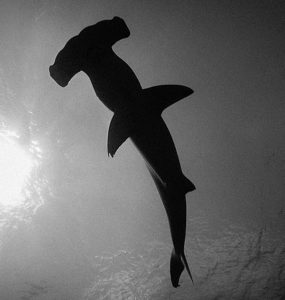 water, was a great hammerhead shark many feet in length. The distinctive chocolate-brown back broke the water barely a dozen feet from our boat. As suddenly as it had appeared, the shark was gone. We excitedly congratulated each other’s good fortune in seeing such an extraordinary animal. Inwardly each of us reflected upon the possibility that this fellow might have friends swimming the waters closer to our island destination.
water, was a great hammerhead shark many feet in length. The distinctive chocolate-brown back broke the water barely a dozen feet from our boat. As suddenly as it had appeared, the shark was gone. We excitedly congratulated each other’s good fortune in seeing such an extraordinary animal. Inwardly each of us reflected upon the possibility that this fellow might have friends swimming the waters closer to our island destination.
The remainder of our voyage was uneventful and finally we entered the channel between the little island on the left and the big island to the south. Pulau Perhentian Kecil had a small Malay fishing village on its leeward shore. As noted, Pulau Perhentian Besar was uninhabited and its mountainous slopes were covered in thick forest. There was a small government rest house somewhere on its southeastern shore but we were told it was seldom used. Thus, it appeared that the island would be ours alone for the next few days.
Our boatmen told us that they would put us ashore on a beach which was beyond the rocky headland lying just ahead of us. In our excited anticipation we chattered away about what an excellent adventure awaited us. We rounded the point and beheld our landing site. With that, the jabbering abruptly stopped. We were all stunned into silence. The vista we observed was a postcard from Eden. It must surely be a mirage, a hallucination, a dream! But no, it was real. I suddenly recognized that I was actually seeing with my own eyes a tropical paradise of the kind I had heard rumored as a child.
Stretched out before us was a broadly U-shaped beach of brilliant sugary-white sand. Along its entire length, the beach was lined by towering coconut palms. The trees arched outward over the beach and offered a shadowy, highlighted edge to the dazzlingly white sand. The water in the small bay formed by the island’s curvature was a magnificent turquoise-blue and its clarity was stunning. I glanced over the side of the boat and could easily see small stones lying on the sandy bottom in nearly 50 feet of water. It was quite simply the most translucent body of water I had ever seen.

Our boat soon nudged the bottom and came to rest. We discussed the particulars of when the fisher-folk would return to get us and bade them goodbye. With that, we gathered our few belongings and waded through the lukewarm water to shore. Thirty yards back from the beach there was a small shelter consisting of a roof set atop four posts. Under this we pitched our canvas tent; a refuge in case of rain. The tent was never used. During the day we were sheltered by the coconut palms and at night we simply slept on light blankets spread upon the sand. We cooked over a campfire and subsisted for the brief three days on a diet consisting primarily of the aforementioned rice and canned fish.
We were sometimes awakened in the wee hours of the night by the metallic sound of tin cans being gently nudged about. Flipping on our flashlights, we found hermit crabs busily working on the remaining scraps of food within the tins we had temporarily cached on the sand. On other evenings we heard a commotion in the palm trees over our beachfront beds. Scanning the palm canopies we saw several flying foxes noisily congregating in the trees. These are the largest bats in the world with a wingspan of three or four feet. Their faces do indeed look more like that of a small dog than the countenance we usually associate with a bat. Being harmless fruit-eaters, we left the bats to their socializing and tucked ourselves back into our bedrolls. The gentle lapping of the waves upon the shoreline near our feet soon lulled us back to sleep.
The rising of the morning sun roused us from our blankets and, as we set about making coffee, we speculated upon what the day’s snorkeling might bring. The fringing reef we wanted to explore lined the east and west sides of our cove. The corals appeared, just below the surface of the crystal-clear water, as a darker smudge upon the white sand of the bottom. At last with great anticipation, we grabbed our masks and snorkels and waded out. As we reached the reef, we found that the water was still only a bit over waist deep. Hardly believing that the coral was so easily reached, I lowered my mask and submerged myself below the surface for a first look.
What I saw astonished me. As a land-locked Hoosier, I had never imagined that such a wondrous natural world could really exist. Granted, I had seen the Jacque Cousteau and National Geographic specials. I knew that coral reefs were amazing repositories of marine life; but that was TV. This was real! This was 3-D! This was in full color! This was alive!
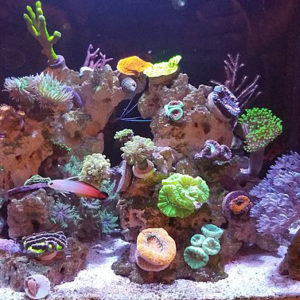 Stretching before me was a multicolored vista of corals. There were rounded forms of solitary corals like Fungia (looking a bit like a mushroom cap) and the aptly named brain coral with its ridged and furrowed cerebral-like form. There were fan-shaped corals, branching corals like Acropora (staghorn), and corals that were soft instead of stony. Underlying all these were the reef-building corals. Their growth over the millennia had produced the limestone bulwark of the reef. Even now the living polyp animals covering the reef surfaces were working away. Their tentacled, tubular bodies were busily converting carbon, calcium, and oxygen into the stony skeletons we recognize as the reef. One might suppose that all this variety existed in a uniform, concrete-like color but this was not so. Scanning the reef, I could see animals of purple, blue, red, yellow, black, and brown. Each color represented a different species of reef organism. Here and there, embedded in the reef itself, I could see individuals of Tridacna, the giant clam. The reef had
Stretching before me was a multicolored vista of corals. There were rounded forms of solitary corals like Fungia (looking a bit like a mushroom cap) and the aptly named brain coral with its ridged and furrowed cerebral-like form. There were fan-shaped corals, branching corals like Acropora (staghorn), and corals that were soft instead of stony. Underlying all these were the reef-building corals. Their growth over the millennia had produced the limestone bulwark of the reef. Even now the living polyp animals covering the reef surfaces were working away. Their tentacled, tubular bodies were busily converting carbon, calcium, and oxygen into the stony skeletons we recognize as the reef. One might suppose that all this variety existed in a uniform, concrete-like color but this was not so. Scanning the reef, I could see animals of purple, blue, red, yellow, black, and brown. Each color represented a different species of reef organism. Here and there, embedded in the reef itself, I could see individuals of Tridacna, the giant clam. The reef had  literally grown around the larger ones imprisoning them in stone. By periodically opening and closing their shells, they had created a snug space within the reef for themselves. The monstrous clams (the largest ever found weighed over 500 lbs.) lie there with their valves agape filtering water through their mantle cavity in the constant need for freshly oxygenated water and planktonic food.
literally grown around the larger ones imprisoning them in stone. By periodically opening and closing their shells, they had created a snug space within the reef for themselves. The monstrous clams (the largest ever found weighed over 500 lbs.) lie there with their valves agape filtering water through their mantle cavity in the constant need for freshly oxygenated water and planktonic food.
The sandy bottom was littered with sea cucumbers. Some were smooth-skinned, tarry-black in color and resembled a legless, unsegmented  caterpillar. Other kinds were nearly two feet in length with tan, spiny skin. All of them crept about on tiny, suction-creating tube feet as they vacuumed up sand and sorted from it the organic detritus which fed them. Arthropods such as shrimp and lobsters prowled the surface of the coral and probed its many crannies in their search for a meal or a secretive hiding spot.
caterpillar. Other kinds were nearly two feet in length with tan, spiny skin. All of them crept about on tiny, suction-creating tube feet as they vacuumed up sand and sorted from it the organic detritus which fed them. Arthropods such as shrimp and lobsters prowled the surface of the coral and probed its many crannies in their search for a meal or a secretive hiding spot.
The fish of the reef represented a whole other world of color. There were strikingly orange-colored clownfish (someday to star in the as yet 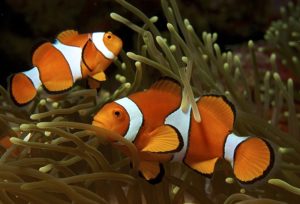 unimagined role of Nemo). These retreated seductively into their sea anemone homes as they attempted to lure me – just another big fish to them – into the poisonous tentacles of the anemones. There were exquisitely colored butterfly fish, their little
unimagined role of Nemo). These retreated seductively into their sea anemone homes as they attempted to lure me – just another big fish to them – into the poisonous tentacles of the anemones. There were exquisitely colored butterfly fish, their little 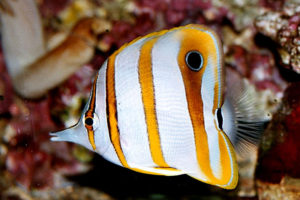 beak-like snouts probing the corals for algae and plankton. Parrot fish, with their massive teeth exposed in a perpetual smile, cruised over the coral.
beak-like snouts probing the corals for algae and plankton. Parrot fish, with their massive teeth exposed in a perpetual smile, cruised over the coral.
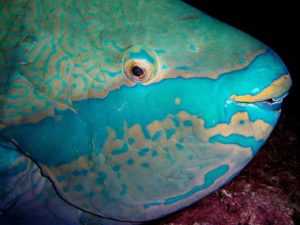
Occasionally they stopped to use these teeth to nip off chunks of coral. In this way, they fed upon the coral polyps and produced as waste a fine sand which drifted to the bottom.
Lurking in the dark recesses of the coral, I would occasionally catch sight of a huge grouper. Mottled in camouflaging colors, they were lying in wait for some hapless piscine prey to swim past. And then of course, there were sharks.
Recalling the huge hammerhead we had seen on the way over to the island, I had entered the water with some trepidation. However as I marveled at the sights of the reef, sharks had been shuffled to the back of my memory. So it was that I was totally unprepared to have a shark swim past directly beneath me as I swam out over a sandy bottom. My response was automatic, or should I say autonomic. It was the old fight or flight response I had learned about in physiology class. My heart rate climbed to about one-twenty, seemingly instantly. I’m sure my pupils dilated, blood sugar increased, and my hair stood on end. The shark was swimming along at a good clip and as I watched it swim away from me my fear subsided. With some embarrassment, I now realized that the fish which at first glance might have been a huge great white was actually a little fellow about three feet long. Such is the innate fear sharks conjure in the human mind I suppose. Other small sharks and a beautiful spotted eagle ray were encountered during our stay on Perhentian, but none generated the alarm caused by that first-ever sighting of a shark so closely sharing my water.
But my favorite shark memory comes from a later dive made on this lovely island. Since Michelle was only eight, she needed some assistance in maintaining the endurance to snorkel for an extended period. Anne and I nudged her along with us on a small Styrofoam float. She could either push this ahead of her or rest upon it if needed. Slowly we all once again snorkeled over the wonderful reef enjoying its breathtaking beauty. The water in which we were swimming was, in this instance, quite shallow; only covering the reef to a depth of about three feet. As we paddled over the corals, I happened to look up into the distance in time to see a form becoming visible a few yards in front of us. Like a specter that might suddenly appear in a dimly lit room, the figure of a shark loomed into view. So perfect was the counter-shading coloration of the shark that it seemed to simply materialize from the water molecules themselves. It wasn’t there; then it was there. With slow, rhythmic, lateral undulations of the caudal fin and body the white tip reef shark slowly advanced our way. This shark was not the little juvenile of my first experience. Here was an adult fully as large as myself. Judging from the pelvic fin anatomy it was a male. Again there was that hint of antediluvian alarm stirred by the proximity of this large, apex predator. But as I watched the great fish slowly patrolling above the reef a new emotion emerged.
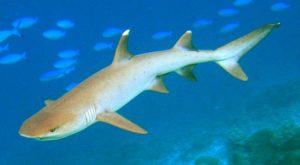
The grace and beauty being exhibited by the shark were stunningly beautiful. Suddenly it became very clear to me that I was seeing more than a lovely animal at home in its native habitat. I was comprehending the wonder of what three-hundred million years of evolutionary adaptation could accomplish. I really felt awe-stricken.
Tethered to a gaseous atmosphere by my snorkel, I marveled at the effortless coordination of pharyngeal musculature which passed life-sustaining oxygen over the shark’s five pairs of gills. Whereas by passage through the water required huge effort in order to overcome friction drag, the fusiform body of the shark seemed to slide through the water as if were moving in air. At this depth, I had no cognizance of water pressure or the movement of other animals nearby. Yet I knew that the neural cells along the shark’s lateral line were, like the most complex barometer, constantly monitoring its pressure/depth. These cells were also sending continuous feedback to the brain of any compression waves created by nearby movement from other fishes – and perhaps us I wondered? The struggles of an injured or diseased fish would draw instant attention from the white tip.
My sense of smell was inoperative as I paddled along the surface of the cove. The shark’s olfactory system was, on the other hand, operating at full efficiency. He could follow a blood trail through the water to a wounded fish hundreds of yards distant. As surely as my little, long-departed beagle Herman could follow the track of a fleeing rabbit; the reef shark could use its “nose” to track down an odoriferous source of food.
The water in which we swam with the shark was of crystalline clarity. Yet I also knew that even in the murkiest of waters the shark would know of our presence. Sprinkled liberally over its face were dozens upon dozens of tiny, dark speckles. In reality, each of these was a small pore ending in a sac-like structure known as an ampulla of Lorenzini. These too were nervous system organs of miraculous function. The ampullae were able to detect the bioelectric aura given off by living animals. We know this bioelectric quality exists because we measure it upon our own skin when we submit to an EKG. What would it be like to sense someone’s presence in a darkened room through the very pores of one’s skin? If only the shark could tell us. If only it could tell us what it feels like to have survived hundreds of millions of years of earth’s turmoil, climatic changes, asteroid impacts, and now the humiliation of being seen as nothing more than a source of shark fin soup.
These were the thoughts I entertained as the noble white tip reef shark turned away from us. Without answering my questions, and using the same graceful movements of fin and body which had brought him into his brief contact with us, he dematerialized back into a world I could only ponder in wonderment.
______________________________________________________________________________
A Postscript:
Uninhabited at the time of our visit, Tripadvisor.com now lists some thirty resort properties on Pulau Perhentian Besar.
https://www.tripadvisor.com/HotelsList-Pulau_Perhentian_Besar-Beach-Resorts-zfp12675422.html
Since our encounter with the beautiful white tip reef shark, shark populations throughout the world’s oceans have declined by 71%.
Photo Credits:
grey reef shark by Chris Hub @ commons.wikimedia.org hammerhead shark by Chris Mikael Krister @ commons.wikimedia.org coral reef by Treetopz @ commons.wikimedia.org clown fish by Nick Hobgood @ commons.wikimedia.org parrot fish by Gustavo Gerdel @ commons.wikimedia.org butterfly fish by Turner Hof @commons.wikimedia.org giant clam by CIA @commons.wikimedia.org sea cucumber by Jacinta Richardson & Paul Fenwick @ commons.wikimedia.org white tip reef shark by Jan Derk @commons.wikimedia.org all others by the author
